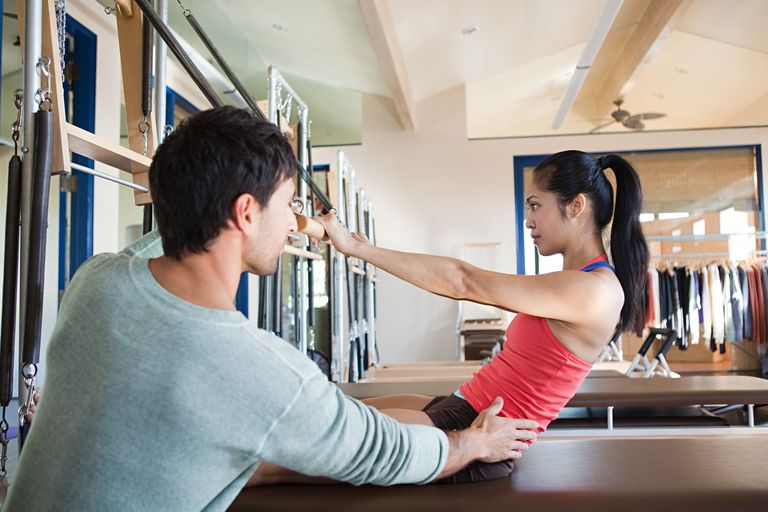Group Classes vs. Personal Training: Which Is Best?
Personal Training May Give You More Bang for Your Buck
By Alycea Ungaro, PT, MS
Updated July 25, 2016

USA, New Jersey, Jersey City, Portrait of senior woman exercising with dumbbells in gym
Let me whisper in your ear. If you’ve ever felt that groaning feeling when a friend grabs you by the arm to drag you to her spin class or found yourself staring at the exit sign in a hot yoga studio, you may be cut out for an entirely different kind of training.
Despite the popularity of group fitness, one-on-one personal training provides superior results and techniques for the large majority of exercisers.
Let’s compare the differences and why you may want to opt for individual training over group classes.
Supervision and Safety
A fitness instructor’s role is not just to deliver fun workouts. An instructor’s primary role is to keep students safe, in good form and proper alignment regardless of the exercise method.
In any group class, an instructors’ attention is necessarily divided among the number of participants. This subjects students to reduced supervision, minimal safety and questionable form and alignment.
By contrast, a personal training session ensures that you have one hundred percent of your teacher’s attention. As a result, it will be safer and better controlled for proper anatomical form and alignment.
Is it worth it? Group classes come in at a fraction of the cost. However, the amount of injuries that happen in group class workouts is staggering. Beyond the obvious cost of an injury, the setback to your fitness goals is considerable.
Consider the cost of rehabbing from a torn muscle, a dislocation or a herniated disc. The downtime, loss in productivity and cost of health care alone should be enough to convince you that it’s worth it to pony up for one-on-one training.
Motivation and Goals
Group workouts are defined by mantras, music and enthusiastic cheerleading.
All in all, it’s a terrific formula to keep you coming back for more. Unfortunately, just showing up isn’t always enough.
The substance and content of the workout will determine your actual results regardless of strobe lights and entertainment value.
In personal training, you are motivated through each and every move by a trainer who is intimately familiar with your weaknesses, strengths and needs. Results both small and big are tracked and acknowledged consistently, providing the powerful motivator of positive reinforcement. regardless of strobe lights and entertainment value.
Is it worth it? Weekend warriors burn out fast. Motivation is the most elusive long-term element for any exerciser. Unless conditions are just right and results are regularly achieved, your motivation will drop off over and over again.
Realistic goal setting is key to establishing and maintaining proper results. Workouts which over promise movie star results in minimal time are doing a great job selling but they usually can’t deliver.
If you expect dramatic results and don’t get them immediately, you’ll find yourself shopping for a new workout.
Working with a dedicated coach will ensure your motivation remains consistent and your workouts continually progress. A proper kick off is key to sustained motivation. A custom built program that establishes your true starting point is invaluable to your success.
The Story of You: Custom Results
Group workouts are built upon very general fitness principles and one-size-fits-all programming. Boutique gyms formulate their workouts for the “normal healthy” body. There is no comprehensive assessment of your ability or limitations when you walk into a group class.
Regardless of the modifications offered in group training, without an actual intake process such as an interview and assessment, the exercises can not be sufficiently adjusted to your custom needs. Private training does just the opposite.
Beginning with a proper evaluation, your workouts are built specifically to address your goals. And not just for your body type, but in consideration of your health history and your baseline level of fitness.
Although many of us consider ourselves normal and healthy, there is no real baseline for where workout intensities or structure should begin for a given individual in a group class setting.
Every person who exercises brings their own story. Your family history of disease and medications, your personal history of diet and exercise and your individual metabolism and motivation style all play into your story. Add to that list your own physical body type.
Beyond all these factors is your wish list. What are you looking for from your workouts? Your personal goals are a driving factor in your workouts with your trainer. Within the sphere of personal training, your established goals are a constant point of reference in your sessions and will steer your instructor to customize your plan.
In a group class, you’re pretty much on your own with your goals and wish list.
Is it worth it? Of course, budgets vary and personal training is at the top of the exercise food chain in terms of expense. However, personal training sessions are also at the top of the food chain in terms of results.
When it comes to your body, what price is too high to pay for an exercise program that serves your own personal needs and goals? This is an investment that you may not be able to skip.
Personal training exists in many formats, from trainers inside big box gyms to those that visit you at home.

If you have tried it once or twice but weren’t convinced, consider Pilates as a test drive into personal training. The signature resistance training utilized by Pilates trainers coupled with their advanced training in programming and anatomy will ensure you have a personalized workout created specifically according to your capacity and your long term goals.
If the budget constraints are too prohibitive, a Pilates studio is ideal. The group classes typically max out at eight or ten as opposed to the thirty to sixty in a cycling, yoga or even barre class. If you can have a solid ten or fifteen percent of your teachers time and attention as opposed to two to four minutes in an hour, you’ll get far more bang for your buck.

/about/GettyImages-506148764-5702cd385f9b581408a7e69d.jpg)
/about/foamrollercalf-57323bf15f9b58723d27b1cb.jpg)
/about/foamrollerquads-57323c6c3df78c6bb071b035.jpg)





